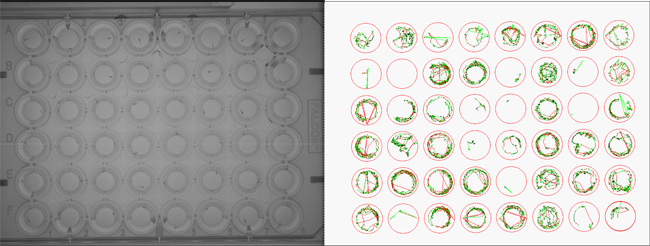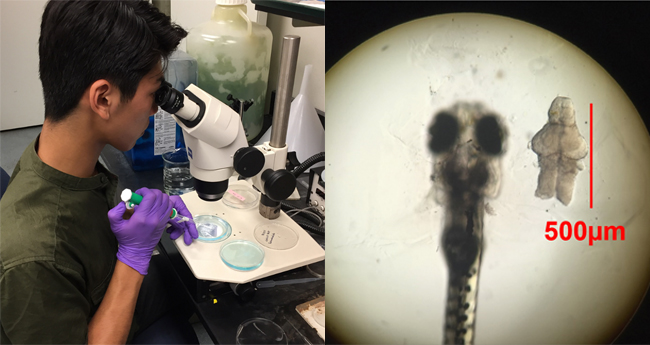
The swim behavior apparatus tracks the distance swam, number of movements made, and duration of activity of up to 48 larval zebrafish. This analysis is used to see how individual pharmaceuticals impact fish behavior as well as how effective wastewater treatment plants are at removing compounds that might affect fish behavior.
— By Chris Gonzales, Freelance Science Writer, New York Sea Grant
Stony Brook, NY, August 15, 2023 - Psychiatric medicines are among the most widely-prescribed and fastest-growing classes of medicines in the U.S.1 Their use increased about 65% between 1999 and 2014, according to the National Center for Health Statistics.2 3 Since about the mid-2000s, growing numbers of scientists have become concerned about exactly what happens to the breakdown products (waste products and metabolites) after psychiatric medicines are processed by humans, leave the body, and enter the waste stream.
Leaders Study a Problem
Anne McElroy, a biologist in the School of Marine and Atmospheric Sciences (SoMAS) at Stony Brook University (SBU), and her colleagues Diana Aga at the University at Buffalo (UB) and Howard Sirotkin and Bruce Brownawell at SBU were awarded a grant in 2016 to study the potential harmful effects of psychiatric medicines for New York’s Great Lakes and its estuaries. They developed a study in collaboration with waste-water treatment plants (WWTPs) so that engineers and researchers could update their processes, and thereby create cleaner water for the greatest number of people. Another arm of their research was to study aquatic organisms in particular, looking for signs or markers of the effects of prescription medicines.
“The beginning of this research came with advances in analytical chemistry that documented environmental releases of a new group of contaminants, released mostly through WWTPs,” said McElroy. “Their study focused on a class of polar contaminants—specifically pharmaceuticals. Environmental releases of these more polar materials cannot be followed using the traditional methods developed in previous decades to measure so-called legacy contaminants such as PCBs and many pesticides.”
She and her partners completed New York Sea Grant (NYSG)-funded study in 2019. The research, including the development of extensive analytic methods, led to additional funding being obtained from the Hudson River Foundation (HRF) to implement these methods across a much larger area, at numerous locations up and down the Hudson River.
A Different Outlook
The types of waste flowing through WWTP systems have changed in the last 60 years. Psychiatric medicines, along with other items such as personal care products and plastics, are a big component of that change.
Given the growing concern about this issue worldwide, scientists are hard at work trying to find ways to both prevent this type of pollution, but also to efficiently measure the scale of the problem.
They’ve found, for instance, that the breakdown products of psychiatric medicines are sometimes just as potent as the original pills on the brains of fish. Investigators are also trying to identify chemical or behavioral markers in fish and other aquatic organisms that could be a signal for us to set up barriers and filters at key entry points in water systems.

(Left) High school intern Tyler Masuyama prepares for a larval zebrafish brain dissection; (Right) A larval zebrafish (background) and its brain (foreground with scale bar). Larval zebrafish were treated with antidepressants and their brains were dissected. Scientists use RNA sequencing to try to detect which genes are responsive to antidepressant treatment.
Advanced Filter Technology
McElroy is leading a team of scientists to investigate not only the risks, but also possible interventions, stopgap measures, and long-term solutions.
Generally speaking, traditional (so called secondary) WWTP treatments do not remove the contaminants we tend to find in trace amounts in wastewater. For this reason, researchers are particularly interested in advanced processes like activated carbon filters or ozonation. (A company that provides this type of equipment to municipalities collaborated in the research.4)
The levels of contaminants found in the treated waters released were lower—in fact, 1/100th or less—than would induce observable, toxic effects. However, the effects of chronic, long-term exposure are unknown; researchers still want to pursue that area of study.
Biomarkers
One of McElroy’s team members is a scientist named Irvin Huang, currently a scientist with the U.S. Fish and Wildlife Service (USFWS) working on Endangered Species listings. He and his fellow investigators published a paper early in 2019 about behavioral changes—specifically, altered swimming ability—they observed in larval zebrafish. They assessed 15 common neuroactive drugs, such as antidepressants, anticonvulsants, antipsychotics, and pain killers, as well as three major antidepressant metabolites, or breakdown products. In the different scenarios they tested in the lab, antidepressants were most likely to alter swimming behavior.5
“If we exposed the same drug to larvae for different amounts of time or started the exposure at different stages of development, we observed different sensitivities and behavioral effects,” said Huang. “Reduction in movement in response to a startle stimulus was the most common behavioral effect observed, although even within a class of drugs such as antidepressants, large variations in sensitivity of response were found.”
A Closer Look at Fish
Huang became interested in detecting behavioral changes in fish, as they would be an efficient way to measure and track the effects of pharmaceutical contaminants on the organisms.
He has been studying the larval zebrafish to develop an efficient and sensitive screen for harm to the tiny growing organism. Since contamination from prescription medicines do not kill the organism, this type of harm is called a “sublethal effect.”
In the lab, he found changes in the swimming activity of the larval fish in contact with antidepressants, anticonvulsants, and typical antipsychotics.
Other investigators have found that developmental and metabolic processes of fish are influenced by exposure to the meds in the lab at their earliest life stages. They see the potential for “more severe developmental and metabolic effects” if fish are chronically exposed into adulthood.
“If we better understand how these drugs cause their effects,” said Huang, “we can make more sensitive predictions and manage urban environments to preserve our natural resources.”
“These advanced treatment methods at WWTPs are widely in use; we have the designs; it may cost us more to implement them, but it will be worth it to protect the environment and people’s health,” said McElroy.
In sum, no short-term behavior effects were associated with psychiatric medicines at levels typically found in the environment. However, chronic effects on organisms living in waters receiving WWTP inputs should still be evaluated, especially as population and psychiatric medicines are likely to continue to rise. Fortunately, advanced treatment methods are known to be effective in removing these contaminants if necessary.
References
1 Chen, Y. et al., 2008. "Utilization, price, and spending trends for antidepressants in the US Medicaid program". Research in Social & Administrative Pharmacy, 4(3):244-57.
2 Antidepressant Use Among Persons Aged 12 and Over: United States, 2011–2014. NCHS Data Brief
3 "Antidepressants found in fish brains in Great Lakes region". University at Buffalo, News Center
4 Hsu, Charlotte. (2020). “Study: How U.S. sewage plants can remove medicines from wastewater”. University at Buffalo, News Center
5 Huang, I., et al. (2019). “Varying the exposure period and duration of neuroactive pharmaceuticals and their metabolites modulates effects on the visual motor response in zebrafish (Danio rerio) larvae". Neurotoxicology and Teratology. 72:39-48.
More Info: New York Sea Grant
New York Sea Grant (NYSG), a cooperative program of Cornell University
and the State University of New York (SUNY), is one of 34 university-based
programs under the National Oceanic and Atmospheric Administration’s
National Sea Grant College Program.
Since 1971, NYSG has represented a statewide network of integrated
research, education and extension services promoting coastal community
economic vitality, environmental sustainability and citizen awareness
and understanding about the State’s marine and Great Lakes resources.
Through NYSG’s efforts, the combined talents of university scientists
and extension specialists help develop and transfer science-based
information to many coastal user groups—businesses and industries,
federal, state and local government decision-makers and agency managers,
educators, the media and the interested public.
The program maintains Great Lakes offices at Cornell University, SUNY
Buffalo, SUNY Oswego and the Wayne County Cooperative Extension office
in Newark. In the State's marine waters, NYSG has offices at Stony Brook
University and with Cornell Cooperative Extension of Nassau County on Long Island, Brooklyn College and Cornell Cooperative
Extension in NYC and Kingston in the Hudson Valley.
For updates on Sea Grant activities: www.nyseagrant.org has RSS, Facebook, Twitter, Instagram, and YouTube links. NYSG offers a free e-list sign up via www.nyseagrant.org/nycoastlines for its flagship publication, NY Coastlines/Currents, which is published quarterly.